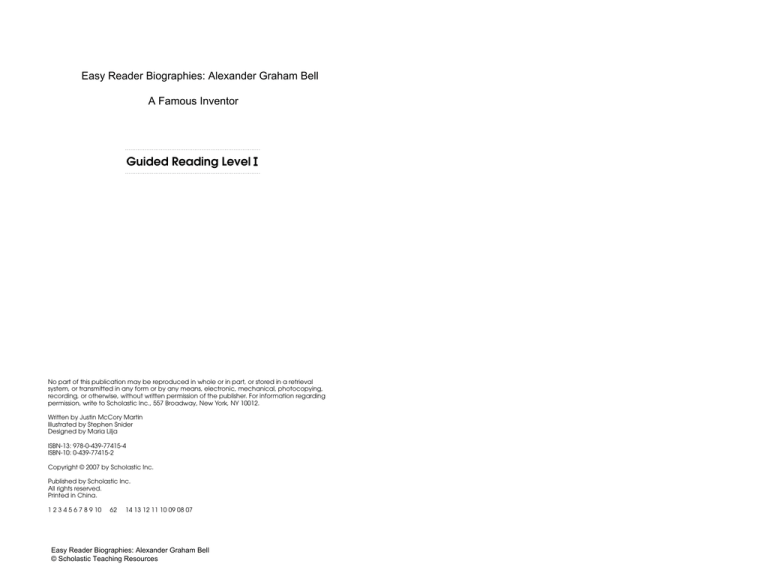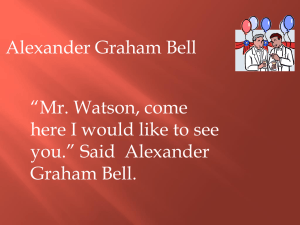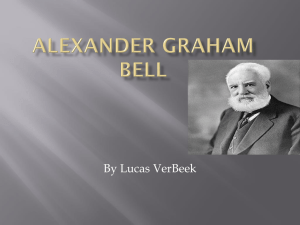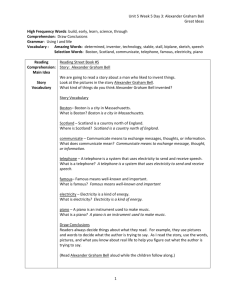
Easy Reader Biographies: Alexander Graham Bell
A Famous Inventor
Guided Reading Level --I
No part of this publication may be reproduced in whole or in part, or stored in a retrieval
system, or transmitted in any form or by any means, electronic, mechanical, photocopying,
recording, or otherwise, without written permission of the publisher. For information regarding
permission, write to Scholastic Inc., 557 Broadway, New York, NY 10012.
Written by Justin McCory Martin
Illustrated by Stephen Snider
Designed by Maria Lilja
ISBN-13: 978-0-439-77415-4
ISBN-10: 0-439-77415-2
Copyright © 2007 by Scholastic Inc.
Published by Scholastic Inc.
All rights reserved.
Printed in China.
1 2 3 4 5 6 7 8 9 10
62
14 13 12 11 10 09 08 07
Easy Reader Biographies: Alexander Graham Bell
© Scholastic Teaching Resources
Alexander Graham
Bell lived from
1847 to 1922.
Do you like to talk on the telephone?
Did you ever wonder who invented it?
That person is Alexander Graham Bell.
Keep reading to learn more about
this great inventor.
Easy Reader Biographies: Alexander Graham Bell
© Scholastic Teaching Resources
Aleck’s father wanted
him to study science.
Alexander was born in Scotland in 1847.
His family called him Aleck for short.
Aleck’s father was a teacher who helped
deaf people learn to speak.
Easy Reader Biographies: Alexander Graham Bell
© Scholastic Teaching Resources
Mrs. Bell liked to listen
to Aleck play the piano.
Aleck’s mother lost her hearing as
she grew older. She used an ear tube
to help her hear. Mrs. Bell was an artist
and a piano player. Like his mother,
Aleck learned to play the piano.
Easy Reader Biographies: Alexander Graham Bell
© Scholastic Teaching Resources
Aleck could feel sound
vibrations when his
dog barked.
Aleck became fascinated by sound.
He even studied his pet dog’s barking.
This helped him learn how sounds
are made.
Easy Reader Biographies: Alexander Graham Bell
© Scholastic Teaching Resources
Aleck’s brother would blow
air through a tube. Aleck
would move the machine’s
lips to make it speak.
When he was a teenager, Aleck and
his brother built a talking machine.
It was shaped like a person’s head.
They could make the machine say
simple words like mama.
Easy Reader Biographies: Alexander Graham Bell
© Scholastic Teaching Resources
Alexander showed
his students how to
make sounds.
When Alexander was older, he got a
job at a school in Boston. Like his father,
he taught deaf people how to speak.
Alexander was a great teacher, but he
still wanted to invent things.
Easy Reader Biographies: Alexander Graham Bell
© Scholastic Teaching Resources
In Boston, Alexander met a woman
named Mabel Hubbard. Mabel was
deaf. Later, Mabel and Alexander
got married and had children.
Easy Reader Biographies: Alexander Graham Bell
© Scholastic Teaching Resources
Alexander would work
on his inventions until
late at night.
Alexander stopped teaching so that he
could work on his inventions. He wanted
to create a machine that could send
sounds through a wire.
Easy Reader Biographies: Alexander Graham Bell
© Scholastic Teaching Resources
Thomas began working in
Alexander’s laboratory.
He hired a man named Thomas Watson
to help him. Inventing was hard work.
Sometimes the two men felt like giving
up. But they kept going.
Easy Reader Biographies: Alexander Graham Bell
© Scholastic Teaching Resources
Alexander said into the machine,
“Mr. Watson, come here. I want
to see you!”
On March 10, 1876, something incredible
happened. Alexander was in one room.
Thomas was in another room. But they
could hear each other’s voice through
the machine. The invention was working!
10
Easy Reader Biographies: Alexander Graham Bell
© Scholastic Teaching Resources
The emperor of Brazil was
at the World’s Fair. He tried
Alexander’s new telephone.
Alexander called his invention a
telephone. He entered it in a contest
at the World’s Fair in Philadelphia. At the
fair, he won a prize for his invention.
11
Easy Reader Biographies: Alexander Graham Bell
© Scholastic Teaching Resources
In 1878, Rutherford B. Hayes
became the first United States
president to use a phone.
Whom did he call? Alexander!
Soon Alexander was famous. People
all over the world wanted to find out
about his invention, including the
president of the United States and
the Queen of England.
12
Easy Reader Biographies: Alexander Graham Bell
© Scholastic Teaching Resources
In 1892, Alexander made the
first call between New York
and Chicago.
At first the telephone could be used
only between places that were close
together. But by 1915, it was possible
to make calls all the way across
the country!
13
Easy Reader Biographies: Alexander Graham Bell
© Scholastic Teaching Resources
This plane was one of
Alexander’s inventions.
Alexander continued to invent many
things, such as new kinds of planes
and boats. He also continued to find
ways to help deaf people.
14
Easy Reader Biographies: Alexander Graham Bell
© Scholastic Teaching Resources
1876
1919
1928
1964
1992
Here are five
telephones from
different times.
Alexander worked hard to make people’s
lives better. People will always think of
the telephone as his greatest invention.
The next time you call someone,
remember Alexander Graham Bell.
15
Easy Reader Biographies: Alexander Graham Bell
© Scholastic Teaching Resources
Glossary
deaf (adjective) unable to hear
fascinated (adjective) very interested
incredible (adjective) amazing, hard
to believe
inventor (noun) a person who creates
new machines or other things
laboratory (noun) a place where
a scientist works
tube (noun) a long object that is
empty inside
vibration (noun) a fast, shaking
movement
wire (noun) a long, thin, bendable
piece of metal
16
Easy Reader Biographies: Alexander Graham Bell
© Scholastic Teaching Resources
Alexander Graham Bell
A Famous Inventor
Guided Reading Level: I
Word Count: 631
Average Words Per Page: 39
Spotlight Nonfiction Feature:
Diagram
A
lexander Graham Bell (1847–1922) was an innovator who changed
American life forever. Always fascinated by sound, he began his career
as a teacher of deaf children. Then he began working full-time on his
inventions—and in 1876, he invented the telephone. Throughout his life,
Bell continued to work on different inventions and he continued to find ways
to help deaf people.
Introducing the Book
Activate prior knowledge by asking: When was the
last time you talked to someone on the phone? Who
was it, and how far does this person live from you?
you do it? (You might go in person or send a note.)
How would you stay in touch with a relative who lived
far away? (You would write letters.) Lead children
to see the important role the telephone plays in
their daily lives. Then explain that they’ll be
reading about the man who invented it.
Encourage children to imagine what life was
like before the telephone. Ask: If you wanted to
invite a friend over who lived across town, how would
Spotlight Nonfiction Feature: Diagram
Use the diagram for a mini telephone quiz.
Ask: How did the telephone change from 1876 to
1919? What’s the biggest difference between the 1964
phone and the 1992 phone? Do you think the phone
has improved between 1876 and today? How?
Talk with children about the purpose of diagrams.
Explain that diagrams are pictures that show parts
of something, or how a machine or a process
works. Then explain that some diagrams show
how something (such as an invention) has
changed over time.
Have children turn to page 15. Explain that
the caption tells what information the diagram
shows, and ask a volunteer to read it aloud.
Next, point out the year labels connected to each
telephone. Ask: How is the diagram helpful? Why
might it be better than a written description of each
year’s phone? (It helps readers visualize the phones;
it gives a lot of information in a small space.)
28
A
Using the Reproducible
Book Links
Give children copies of the graphic
organizer on page 29. Explain that the
biography they just read describes how
Alexander Graham Bell invented the
telephone, but it also tells several other
things about his life. Invite children to
write four other things they learned
about Bell.
For more information on Alexander Graham Bell and
the telephone, try these titles:
Easy Reader Biographies: Alexander Graham Bell
© Scholastic Teaching Resources
◆
Alexander Graham Bell by Victoria Sherrow
(Lerner, 2003)
◆
Alexander Graham Bell: An Inventive Life
by Elizabeth MacLeod (Kids Can Press, 1999)
◆
The Telephone by Marc Tyler Nobleman
(Capstone, 2004)
Name ________________________________
Date _______________________
All About Bell
Scholastic Teaching Resources, page 29
Alexander Graham Bell is best known for inventing the telephone.
What else did you learn about him? In each phone, write a detail
from the book.
Easy Reader Biographies: Alexander Graham Bell
© Scholastic Teaching Resources
Easy Reader Biographies: Alexander Graham Bell
© Scholastic Teaching Resources
Date _______________________________
Important Events in ___________________________________’s Life
Write the person’s name on the line. Then write important events in the order in which
they happened.
Sequencing Timeline
Name ____________________________________________
Name ________________________________
Date _______________________
Vocabulary Chart
Record new words on the chart. First, write the vocabulary word.
Next, write what it means. Then, use the word in your own sentence.
Word
What It Means
Easy Reader Biographies: Alexander Graham Bell
© Scholastic Teaching Resources
Sentence Using Word
Easy Reader Biographies: Alexander Graham Bell
© Scholastic Teaching Resources
Date _______________________________
What the Person Was Like:
Important Events in the
Person’s Life:
Name:
How I Feel About the Person:
His or Her Accomplishments:
Write the person’s name in the center box. Then fill in the other boxes.
Character Map
Name ____________________________________________
Easy Reader Biographies: Alexander Graham Bell
© Scholastic Teaching Resources
Date _______________________________
Name _____________________
Both
Name _____________________
Write one person’s name over each circle. Write facts about this person in that circle.
In the center, write what the two people had in common.
Venn Diagram
Name ____________________________________________



